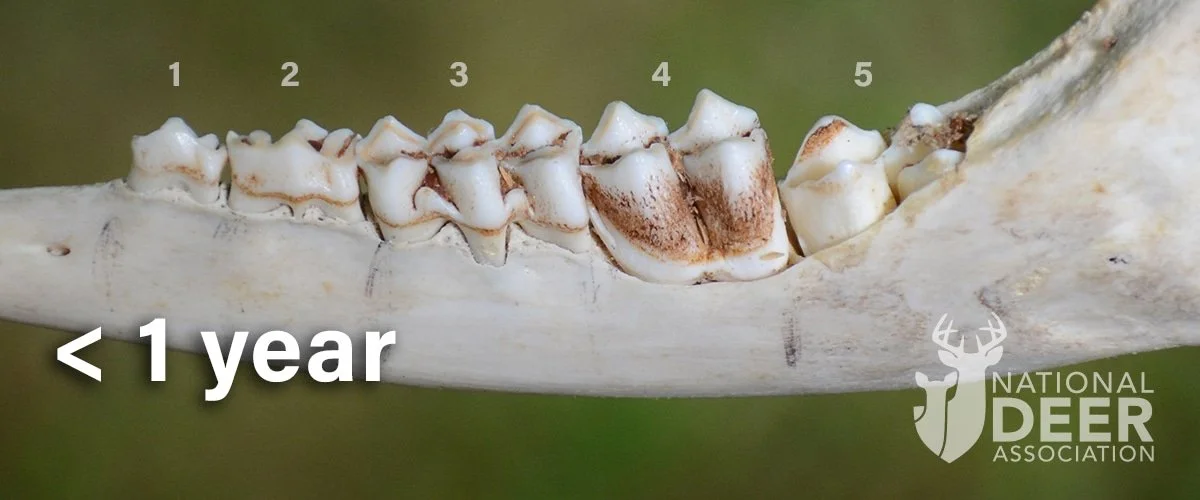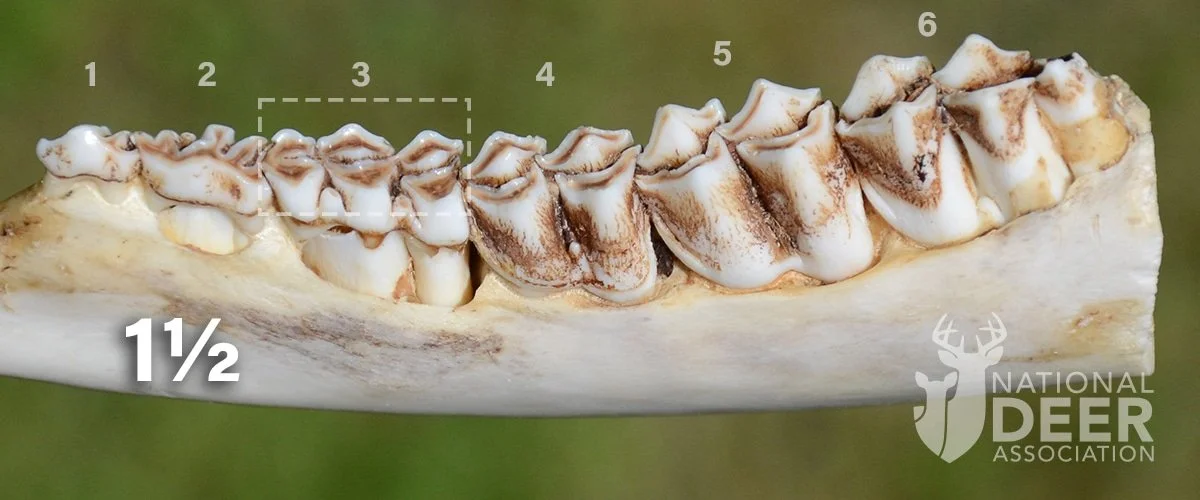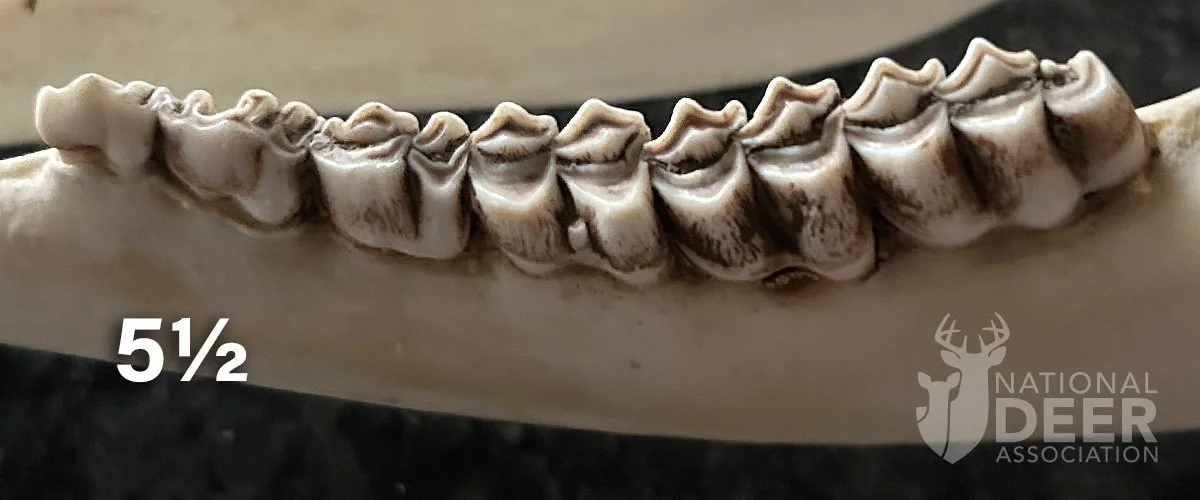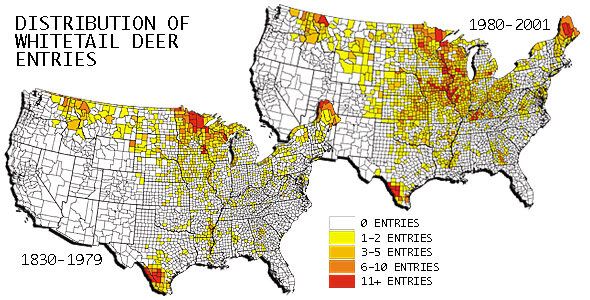
Perfecting your Rx isn’t easy,
hopefully some of our tips can make your management program more manageable.
How to Age Whitetail Deer by Teeth: The Science, History, and Management Power of the Severinghaus Method
“You can’t manage what you can’t measure.”
When it comes to whitetail management, few statements ring truer.
Aging deer accurately is one of the most powerful tools a land manager or wildlife biologist can use. Whether you manage a few hundred acres or a multi-thousand-acre property, understanding the age structure of your herd is the foundation of long-term success.
Among all the methods developed over the decades, none has proven more reliable than aging deer by their teeth — a process first standardized by wildlife biologist C.W. Severinghaus in 1949. His method remains the gold standard for classifying deer by age class, evaluating herd health, and guiding harvest decisions.
The History of Tooth-Based Aging in Whitetail Deer
In 1949, C.W. Severinghaus published his groundbreaking paper “Tooth Development and Wear as Criteria of Age in White-Tailed Deer” in the Journal of Wildlife Management.
By studying hundreds of known-age deer, he discovered two predictable biological patterns:
Tooth Replacement — the consistent eruption of permanent teeth in young deer.
Tooth Wear — the progressive flattening and dentine exposure that increases with age.
This simple, cost-effective method gave wildlife agencies, university researchers, and private land managers a reliable, repeatable system for identifying deer age classes in the field — one still used today across North America.
The Science Behind Why Tooth Aging Works
Whitetail deer have 32 permanent teeth: three premolars (P1–P3) and three molars (M1–M3) on each side of the lower jaw.
Each tooth tells a biological story through eruption timing and wear rate, which are shaped by diet, habitat, and genetics.
Eruption Phase (0–2½ years): Deer replace “milk” premolars with permanent ones on a fixed schedule.
Wear Phase (3½+ years): As deer age, the enamel (white, hard) wears away, exposing darker dentine (brown, soft).
Predictable Ratios: The balance of enamel vs. dentine — and the rounding of each cusp — creates a reliable signature of age.
Studies show that trained biologists can accurately classify deer up to 4½ years old more than 80% of the time using this approach.
For older deer, cementum annuli analysis — counting seasonal growth rings in the tooth root — provides even greater precision.
How to Age Deer by Teeth (Severinghaus Method)
Here’s how to identify each age class using the classic Severinghaus tooth-wear and replacement technique.
Fawn (< 1 Year Old)
Only 4–5 cheek teeth visible.
Third premolar (P3) has three cusps.
Molars not yet erupted.
1½ Years (Yearling)
All six cheek teeth visible.
P3 still has three cusps (deciduous).
M3 newly erupted, sharp, and unworn.
2½ Years
P3 replaced by a two-cusped adult tooth.
M3 fully erupted and sharp.
M1 and M2 show light brown dentine in center of cusps.
3½ Years
M1 and M2 show moderate dentine wear; dentine width roughly equals enamel width.
M3 still sharp and prominent.
4½ Years
M1 and M2 dentine wider than enamel.
M3 beginning to flatten; inner crests starting to round.
5½ Years and Older
All molars heavily worn.
Dentine dominates the chewing surface.
Cusps flattened or cupped, and the jawbone shows visible age rounding.
Why Harvesting Only Mature Bucks (5½+ Years) Strengthens Your Herd
Aging deer by teeth does more than document a harvest — it defines your management philosophy.
Properties that base harvest strictly on age class (not antler points) consistently see stronger genetics, healthier does and fawns, and more stable rut behavior.
1. Full Genetic Expression
Bucks reach their true genetic and skeletal potential between 5½ and 7½ years. Harvesting earlier removes top-end genetics before they’re expressed.
2. Natural Selection Restored
Allowing bucks to mature lets the strongest, most adapted males dominate breeding — spreading those traits naturally across generations.
3. Reduced “High-Grading”
When hunters remove the largest young bucks, they unintentionally remove superior genetics.
An age-based harvest plan prevents that.
4. Social Balance
Older bucks stabilize the rut, regulate dominance behavior, and maintain breeding order — leading to synchronized conception and healthier fawn crops.
Research from the Mississippi State University Deer Lab and Quality Deer Management Association shows that properties enforcing age-class harvest policies see measurable improvements in average antler size, body weight, and herd balance within five years.
Implementing an Age-Class Management Strategy
Collect Jawbones: Save and label every harvested jaw.
Train & Calibrate: Compare your samples against regional known-age references.
Record & Analyze: Track average harvest age, antler metrics, and body weights each season.
Set Clear Policies: Protect bucks under 5½ years; selectively harvest only mature age classes.
Validate With Labs: Send samples to DeerAge.com for cementum annuli verification.
The Whitetail RX Takeaway
A deer’s teeth are a permanent record of its life — every bite tells a story.
By mastering the Severinghaus method, managers gain a deeper biological understanding of their herds and the confidence to make long-term, data-driven decisions.
When you manage for age class instead of inches, you build stronger genetics, better balance, and a sustainable future for your herd and habitat.
At Whitetail RX, we believe that great management doesn’t start with antlers — it starts with biology.
Sources
Severinghaus, C.W. 1949. Tooth Development and Wear as Criteria of Age in White-Tailed Deer. J. Wildlife Management 13:195-216.
Texas Parks & Wildlife. Aging Deer by Tooth Wear and Replacement.
Clemson University Extension. A Key for Aging White-Tailed Deer Using the Tooth Replacement and Wear Technique.
Mississippi State University Extension. Using Antler Restrictions to Manage for Older-Aged Bucks. 2019.
University of Tennessee Extension. Considering Antlers and Estimating Live Age of Bucks. 2020.
Oklahoma State University Extension. Quality Deer Management in Oklahoma. 2020.
National Deer Association Photo Archives, DeerAge.com.
It Starts with Her: How Maternal Nutrition Programs a Buck’s Future
It Starts with Her: How Maternal Nutrition Programs a Buck’s Future
By Whitetail Rx | Deer Science | Whitetail Nutrition & Herd Management
Why Some Bucks Never Reach Their Full Potential
Hunters and land managers have debated it for generations: why do some herds consistently produce giant-bodied, heavy-racked deer — while others, even with similar genetics, fall short?
Is it genetics? Nutrition? Habitat?
The real answer lies in the powerful link between the doe and her developing offspring. Modern wildlife research shows that a buck’s potential for body size and antler growth may be shaped before he ever takes his first steps — in the womb.
The Hidden Influence of the Mother
Research from Texas A&M AgriLife, Mississippi State Deer Lab, and University of Missouri Extension has consistently proven one thing: nutrition drives antler and body growth. Bucks raised in nutrient-rich environments outperform those in poorer habitats — even when their genetics are identical.
The condition of the mother during pregnancy has a lasting impact on how her offspring’s genes are expressed.
When a doe is undernourished or stressed during gestation, her buck fawns are born smaller, develop less muscle and bone density, and grow smaller antlers throughout their life. Conversely, does that maintain excellent body condition during pregnancy give birth to bucks that more fully realize their genetic potential.
The Science: Epigenetics in Deer
So how does this actually happen? The answer lies in epigenetics — a branch of biology that studies how environment affects gene expression.
Epigenetics doesn’t change a deer’s DNA, but it changes how that DNA is read and activated. In mammals, poor maternal nutrition can alter how growth, metabolism, and skeletal genes are expressed in offspring.
Human and livestock studies (Zhu et al., 2019; Chavatte-Palmer et al., 2018) have confirmed that prenatal environment has lifelong consequences on development. In cervids, biologists Flueck & Smith-Flueck (2011) found evidence of similar “phenotypic plasticity” — meaning environmental pressures can change how inherited traits actually show up.
Even with great genetics, a malnourished mother can permanently limit her offspring’s growth potential.
Nutrition: The Gatekeeper of Genetics
According to the Mississippi State Deer Lab, body weight and antler mass respond directly to available nutrition — especially protein and energy during early life. Texas Parks & Wildlife studies show that bucks on a 16% protein diet can grow antlers roughly 20 inches larger than those on 8% protein.
But perhaps the most critical window of all is before birth. During gestation, a doe’s nutrition fuels skeletal and organ development — laying the foundation for future antler mass and frame. If nutrients are lacking, the result isn’t just smaller fawns — it’s smaller, less genetically expressive adults.
Doe management is buck management.
How to Apply This on Your Land
Prioritize Doe Nutrition Year-Round: Late winter through early spring (peak gestation) are critical months. Offer supplemental feed and mineral sources that include protein, fat, calcium, and phosphorus.
Think Year-round On Food Plots: Look for options to make your hunting food plots into year around food plots that allow peak palatability for both in season and off season times of year. Many companies now have rotation blends for this to accomplish this with two plantings or one planting and frost seeding. Top Summer Plot Choices
Soybeans & Cowpeas (iron-clay peas): High-protein legumes that drive milk production and antler growth; in high deer pressure, utilize electric fences to protect during growth phase or plant at scale to prevent early wipe-out.
Lablab: A heat-tolerant legume that shines when it can climb; pair with sorghum or sunflowers for structure and season-long productivity.
Grain sorghum / milo & sunflowers: Add vertical cover, late-season seed heads, and shade for legumes; useful nurse crops in mixed stands.
Clover (annual/perennial): Bridges seasons and boosts diversity; manage for heat and moisture realities in your region.
Manage Habitat Diversity: Encourage native browse and forbs — these natural forages supply essential micronutrients that pellets alone can’t replace.
Control Herd Density: Overcrowding leads to nutritional stress and competition, especially among pregnant does. Balance herd numbers with your habitat’s carrying capacity.
Think Long-Term: Improving doe nutrition this season may not show up on trail cameras until two or three years from now — but the payoff will be measurable.
The Big Picture: Nutrition vs Genetics
The Virginia Department of Wildlife Resources conducted long-term studies showing that once-underperforming herds dramatically improved body and antler size after nutritional conditions improved — proving that environment can unlock “hidden genetics.”
Genetics set the blueprint, but nutrition builds the house.
Final Thoughts
At Whitetail Rx, we believe in managing deer herds from the ground up — literally. That means investing in the health of does, because the next generation’s success depends on it.
A buck’s story doesn’t start with his first set of antlers. It starts in the womb — with a well-fed mother, balanced habitat, and a manager who understands that biology is a long game.
If you want to grow bigger, healthier bucks... start with the Mom.
Sources & References
Texas A&M AgriLife Extension. Nutrition Effects on Fawn, Doe and Buck Deer. Available at: extension.rwfm.tamu.edu
Mississippi State University Deer Ecology & Management Lab. Nutrition and Genetics in Whitetail Deer. Available at: msudeer.msstate.edu
University of Missouri Extension. Antler Development in White-tailed Deer. Available at: extension.missouri.edu
Flueck, W.T. & Smith-Flueck, J.M. (2011). Intraspecific phenotypic variation in deer: the role of genetic and epigenetic processes. Animal Production Science, 51(3), 301–311. DOI: 10.1071/AN10169
Zhu, Y. et al. (2019). Epigenetic Programming and Fetal Metabolic Programming. Frontiers in Endocrinology, 10: 764. Available at: pmc.ncbi.nlm.nih.gov
Chavatte-Palmer, P., Tarrade, A., & Rousseau-Ralliard, D. (2018). Epigenetics, developmental programming and nutrition in mammals. Animal, 12(S2), s363–s374. DOI: 10.1017/S1751731118001337
Virginia Department of Wildlife Resources. (2023). Genetics vs. Nutrition: What Research Shows. Available at: dwr.virginia.gov
© 2025 Whitetail Rx. All Rights Reserved.
Millennium Buck Hut Review & Tips
Quick video review + some tips for longevity on your @millenniumstand Buck Hut Tower Blinds!
We’ve been using these stands for 3 seasons now and have learned a lot in the process. Great bang for your buck!
Summer Food Plots for Year-Around Success
It all begins with an idea.
Food plots…. Where do you start?
Food plots (more specifically the availability of human cultivated food for wildlife either intentionally or not intentionally) have been a hot topic in the land management side of whitetail hunting for over 25 years. It is no secret that the Midwest & North Central US with their giant agriculture fields have been notorious for the growth and harvest of big, mature whitetails for the last century. The prowess of the Midwest & North Central US does still continue to be undeniable. But why are we seeing other states such as Oklahoma, Kansas, Missouri and Texas slowly start to creep up the ranks of B&C States?
As seen in the map, Boone & Crockett (B&C) whitetails being harvested slowly began to spread in frequency further and further into the heart of the country from 1980-2001. This could have been from an increase in the number of hunters or a change in hunting rules and regulations based on bag limit. It is something to note that in the early 1990’s the US whitetail deer population (along with mule deer, blacktail, and other similar species) was borderline hunted to extinction. This could cause the number of B&C harvests to be skewed for those early years. Thankfully, conservation and reintroduction of the species has brought the number of whitetails in the US back up to pre-1990 levels. It would be interesting to see these same B&C figures for 2001-present laid out in a similar map format.
The 1990’s taught us a lot about appropriate harvest numbers and whitetail conservation in general. Since the 1990’s, we have seen a more spread out number of states that have been on the top of the lists for B&C harvests per state. I would argue that the reason for this has been the popularization of whitetail-specific management practices since the 1990’s scare. Not only in the aspect of appropriate age of harvest but also of intentional habitat improvement.
Source: B&C Club
Source: Deerfriendly.com
In addition to stricter harvesting practices including the harvest of proper age class animals and male/female ratios, what is one way to ensure that you have the best possible Whitetail Rx to foster the healthiest deer herd on your lease/property? I would argue that year around high quality food sources is the answer. Many of times, the summer temperatures begin to creep up and we start thinking about summer sports or our favorite cove on the local lake to enjoy a cold beverage with close friends or family. Whitetails are often on the far back of our mind in the spring and summer months. In most areas of the country, the local whitetails do have good browse from wild sources during the “spring green up”. But if our goal is to truly form the perfect Rx for our herd, summer food plots can go a long way to help.
The spring months are a vital time in the life of a whitetail. It is during this time that fawns are being born and bucks begin to form the base of their antler pedicles. This is a very important time for the herd to have high quality browse. This not only fuels the fawns’ development via lactation but also forms a good base of nutrition for the male population to maximize their antler development for the following fall. The fawns will soon encounter their first disease season (such as mild EHD and others) and also be susceptible to predation until they are strong enough to run away. The mothers being able to provide the highest quality milk possible is the best way to protect the fawns through this trying time. There are many factors that help with proper nutrition such as supplemental feeding, wild browse, and thoughtfully planted food plots during the summer months.
In my opinion; an ideal summer food plot would be a plant that A) has a reasonable protein content in order to help with skeletal and body development, B) is able to produce a large amount of biomass in order to survive periods of heavy browse, C) has a high moisture content to help keep the herd hydrated throughout the hot summer months, D) has the ability to be disced/cultipacked on top of the fall crop to help build soil. My favorite seed that fits all of these criteria is quite simple: Buckwheat.
Buckwheat is readily available at most local seed stores and is typically reasonably priced. It is very drought tolerant and less affected by poor soil conditions in comparison to other popular seeds such as soybeans, peas, “summer specific whitetail blends”, etc. Buckwheat is known to be a great smother crop that will shoot up quickly after a controlled burn or discing. Because of this, it blocks sun from getting to native weeds or grasses and will outcompete them in your summer food plots.
If a one acre soybean crop is a 6oz filet mignon, a one acre buckwheat crop would be a 24oz cowboy cut ribeye. Buckwheat produces drastically more biomass per acre when compared to other common summer crops. It also will typically sit between 16-20% protein content which is ideal browse for whitetails in the summer months.
Another characteristic that makes buckwheat an ideal summer crop is the moisture content. Buckwheat is an extremely stocky plant that holds a tremendous amount of moisture in both its leaves and stems. This allows the whitetails to take in a large amount of water from their daily browse. In addition to the benefits to whitetail nutrition, one of the top reasons we have been using buckwheat is for it’s ability to be used in a no-till food plot program. Diving into no-till food plot theory could be an entire additional post. I think that Lindsay Thomas from QDMA did an amazing job of describing “no-till food plots” at the QDMA Whitetail Weekend in 2019. (If you are interested in this, I have included the link next to this section.)
For all of the above reasons, I feel that buckwheat is the perfect Rx for your summer food plots. It is easy to find, inexpensive, and resistant to summer drought & heat. Buckwheat is an unbelievable source of quality, protein-packed browse for your local herd throughout the summer months.
Cheers!
Whitetail Summer Food Plot Rx:
Early/Mid April (depending on planting schedule for your part of the country): Practice weed management via proper chemical treatments (glyphosate, arrest max, etc.) and/or prescribed burns.
During weed prevention and soil prep: Collect a soil sample and apply the necessary lime and fertilizer to get to recommended Ph and soil nutrient levels. Use cultipacker (use a good, high-quality cultipacker for this step. May be an upfront cost but well worth it…) or a light disc (if it is a newly established plot) to work lime and fertilizer into the soil.
Once all weeds are killed and fertilizer needs are met, wait for a good rain.
Just before a good, heavy rain; spread 50 lbs of buckwheat per acre. On newly established plots or ones with less thank ideal soil condition, it may be wise to bump this up to ~60ibs/acre to help smother our remnant weeds and provide more biomass to help with soil for your fall plant. As always, use a good quality cultipacker to ensure good seed/soil contact
Allow plot to grow until it is time to plant fall plots (ideally only 7-8 weeks). Be sure to not allow the buckwheat to go to seed. If it is getting close, mow down to keep it from seeding.
When it is time to plant fall plots; spread preferred fall blend right into the standing buck wheat, cultipack buckwheat stocks over fall seeds, then spray with appropriate amount on glyphosate (~2 quarts/acre) to get a good kill on your buckwheat. The spray is extremely important to ensure that all buckwheat & weeds are dead and also allow the decaying stocks to act as a natural fertilizer and moisture barrier for your fall seeds underneath.













